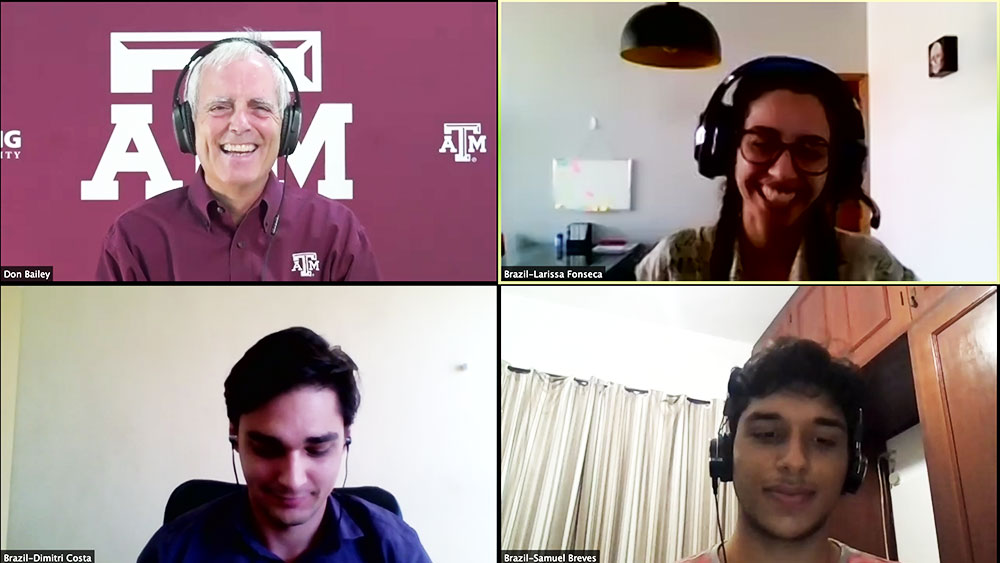
Invent for the Planet (IFTP), an annual competition hosted by Texas A&M University, brought together more than 800 students from nearly 40 universities around the world. The final presentations were held on July 28, 2020, where the final five teams presented virtually and the three winning innovations were announced. First place went to the joint-university team from Brazil, comprised of Centro Federal de Educação Tecnológica Celso Suckow da Fonseca and Universidade Federal do Rio de Janeiro. The team from Texas A&M was in second place and the Makerere University team from Uganda was third.
Each year, the competition has grown as more universities and students ask to participate in the global design challenge. This year was no different. In February, teams from each participating university were challenged to tackle one of 14 challenges set by industry leaders and academics on a range of issues affecting the planet. The teams, representing nearly all continents, were tasked with developing and presenting engineering solutions on their chosen issues during the initial 48-hour weekend challenge. After some local judging and polishing of presentations and prototypes, over 35 teams submitted their innovations to virtual judging after their local competition. Ultimately, the final five were selected.
“It's been an inspiration to see the five teams participate in the IFTP 2020 finals,” said Rodney Boehm, director of Engineering Entrepreneurship and Invent for the Planet. “They overcame the global pandemic to showcase how innovative solutions exist around the globe. We look forward to hosting Invent for the Planet again in 2021.”
One of the unique aspects of the challenge is the final round, where the top teams are invited to Texas A&M to meet other engineers from around the world, and compete in person. After the first round of local competitions in February, no one would have expected that the finals would have to be held virtually due to the safety concerns and travel restrictions from COVID-19.
“The most memorable experience was our ability to quickly and effectively adapt to new circumstances,” said Noble Gutierrez, member of the Texas A&M team ECOtory. “COVID-19 turned the final round of competition into a virtual event, and our team was incredible. We were all fully committed, cooperative, and continued to develop our product and prepare for the competition.”
The winning innovations are:
First Place: Corais - Centro Federal de Educação Tecnológica Celso Suckow da Fonseca and Universidade Federal do Rio de Janeiro, Brazil: Roughly 37% of microplastics found in the world’s oceans are derived from personal care products and synthetic textiles like clothing, expelled in the wastewater from washing machines. Team Corais developed an easy-to-use filter containing magnetite, a recyclable metal, which attracts microplastics and prevents them from being released into waterways.
Second Place: ECOtory - Texas A&M: ECOtory created a sustainable inventory app that allows airlines to better gauge passenger needs in advance. This would then integrate with their inventory systems, reducing excess weight and airline waste, and thus reducing fuel consumption and the contribution to greenhouse gases. Passengers are incentivized with the ability to exchange unwanted meals and amenities for airline miles.
Third Place: Hya Bioplastics - Makerere University, Uganda: The Hya Bioplastics team aimed to solve two environmental issues at once. Their innovation would eliminate single-use, oil-derived plastics through a biodegradable alternative made from water hyacinths, an invasive aquatic weed in the waterways of Uganda. By clearing the lakes of these invasive aquatic weeds to produce the packaging, this design would address multiple local and global problems.
The two runners-up are:
Walkalot – James Madison University, Virginia: The Walkalot team developed a personalized app that promotes walking as the primary mode for transportation in urban environments. Users may select the preferred or most accessible routes when moving around outdoors, like where ramps are available for wheelchair users or which route has the most scenic views.
Crustacean – New Mexico University: In order to address microplastics in the ocean, Crustacean designed a floating buoy with collection bins to trap microplastics and repurpose into reusable materials.
The winners are invited to continue collaborating with event sponsors and the Engineering Entrepreneurship program at Texas A&M. Many of the final five teams have expressed the desire to take their innovation to industry.
“Our team concurrently participated in the NSF I-Corps Site Program, which provides foundational elements for pursuing commercialization,” said Gutierrez. “Our team conducted 30 customer interviews and researched market potential. Receiving feedback from industry professionals, clearly delineating airline needs and further establishing the feasibility of our product has greatly helped our team. We submitted our application to the engineering incubator and are hopeful to have a real-world, viable and industry-implemented solution.”
The event was made possible with numerous volunteers from industry, faculty and staff at participating universities, as well as sponsors Electrocomponents and SOCAR.